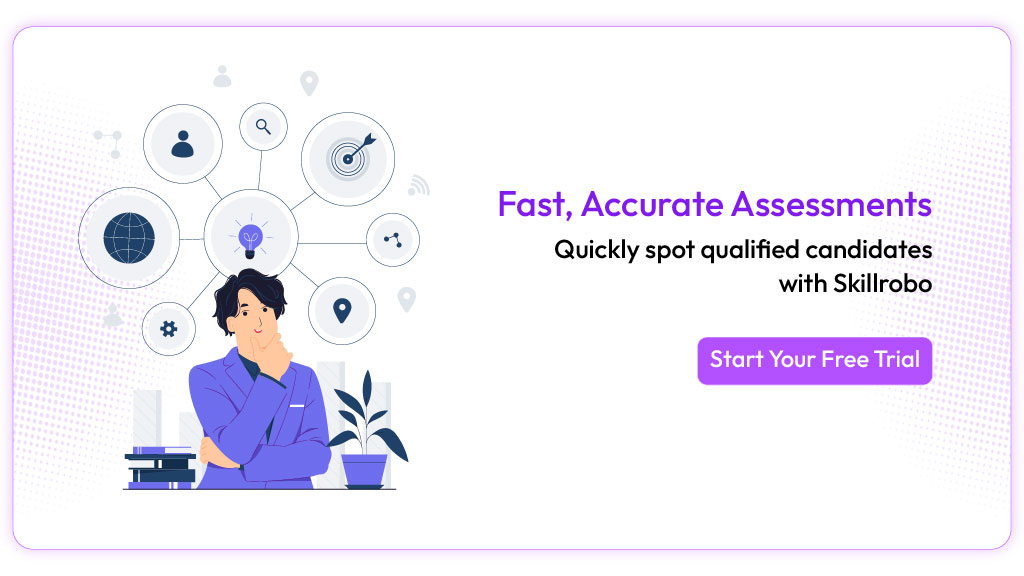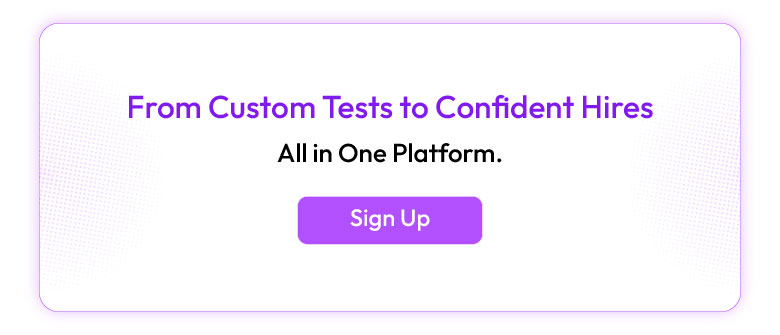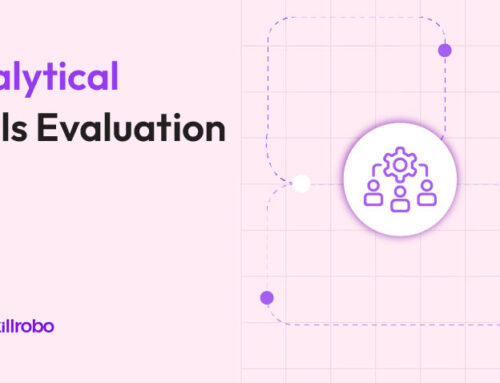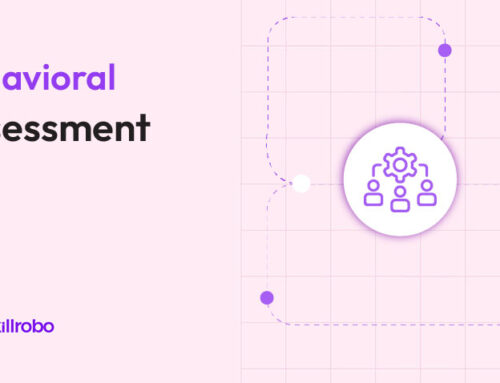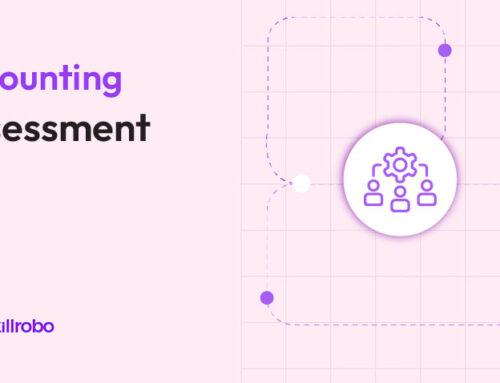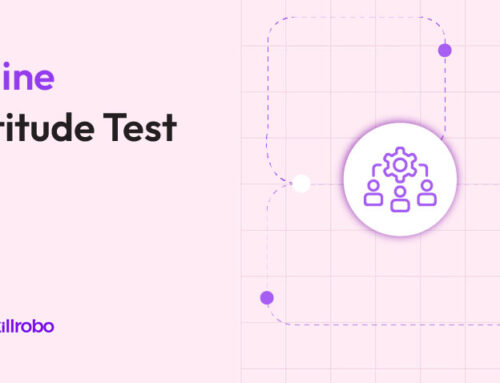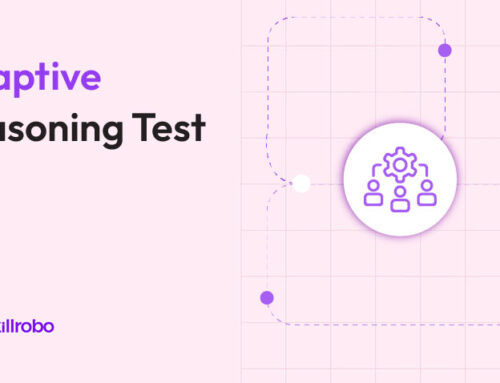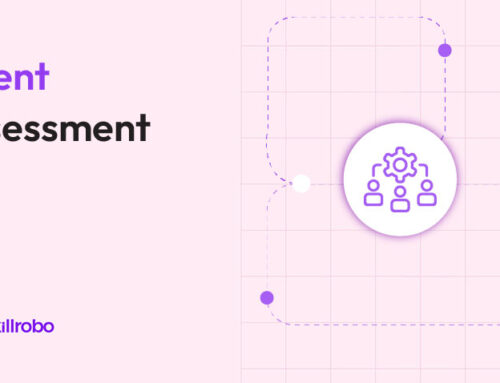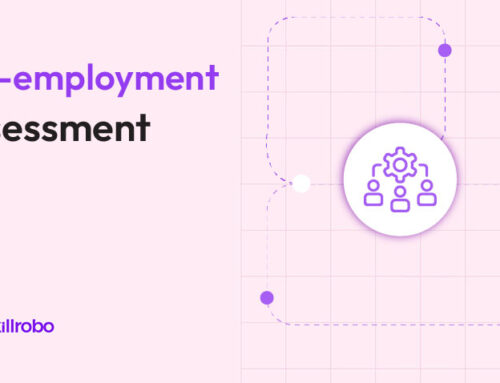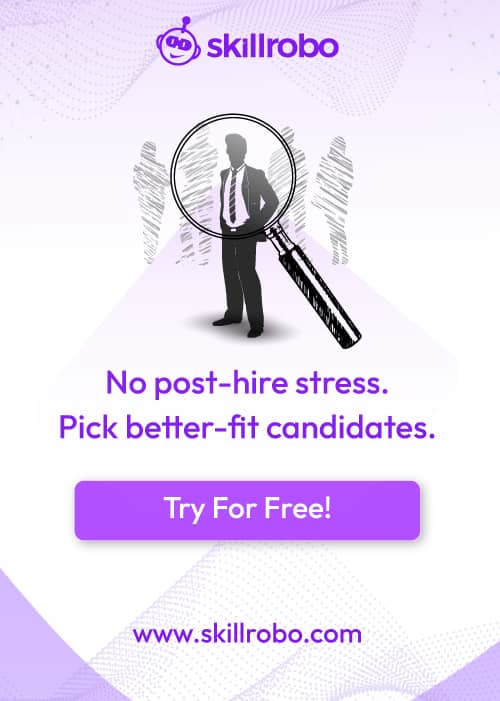Table of Contents
Related articles
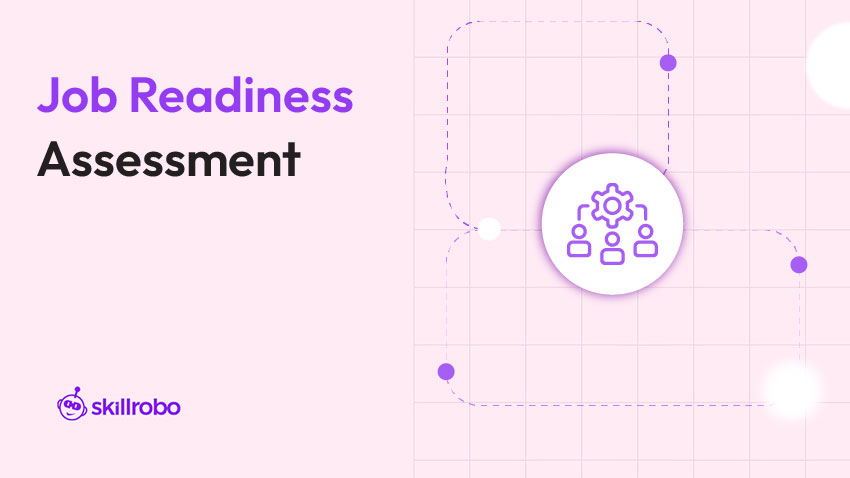
Key Takeaways
- A job readiness assessment evaluates whether a candidate has the skills and traits needed for workplace success.
- It covers soft skills, communication, problem-solving, and professional behavior—not just technical knowledge.
- Using a structured job readiness assessment checklist helps employers standardize hiring for better accuracy.
- Readiness evaluations improve retention, boost productivity, and ensure a job-ready workplace assessment process.
What is Job Readiness and Why Does It Matter?
Hiring the right talent is only part of the equation—ensuring they’re job-ready is what truly drives business performance. But what is job readiness exactly? It’s the level of preparedness a candidate demonstrates in applying professional skills, workplace behaviors, and task management before they even start the role. Today, in the skills-driven job market, companies need more than résumés to evaluate potential. That’s where job readiness assessment comes into play. By systematically evaluating whether individuals are ready to contribute from day one, businesses reduce ramp-up time, lower attrition, and make smarter talent decisions.
In this blog, we explore what is a readiness assessment, how it works, why it’s crucial for building a job-ready workplace, and what tools can make it seamless and scalable.
What is a Job Readiness Assessment?
A job readiness assessment is a structured evaluation used by employers, educators, and workforce teams to determine whether a candidate is prepared for the demands of a professional environment. It goes beyond technical knowledge, focusing on key workplace traits such as communication, adaptability, time management, and professional behavior.
Unlike standard aptitude tests, this assessment measures how well candidates can apply their skills in real-world settings. It helps identify whether someone is not just qualified but also ready to contribute effectively from day one.
Core Areas Evaluated in Job Readiness Assessments
The core areas that are evaluated in a job readiness assessment are as follows –
1. Communication and active listening
This includes verbal and written communication and the ability to listen attentively and respond appropriately. Effective communication is essential for team collaboration, client interactions, and everyday workplace functioning. A well-designed skill assessment often evaluates how candidates articulate ideas and engage in professional dialogue.
2. Time management and punctuality
Being able to prioritize tasks, meet deadlines, and show up on time reflects a candidate’s discipline and reliability. These skills are key to maintaining productivity and minimizing workflow disruptions.
3. Problem-solving and adaptability
Candidates must demonstrate how they analyze issues, develop solutions, and remain flexible in dynamic work environments. Adaptability is especially critical in fast-paced industries or roles that involve frequent change.
4. Teamwork and collaboration
Workplace success often depends on the ability to function well within a team. This includes giving and receiving feedback, resolving conflicts professionally, and contributing to group objectives.
5. Professional attitude and workplace etiquette
From adhering to dress codes to respecting authority and peers, professionalism shapes how well a candidate fits into an organization’s culture. It also influences their long-term growth and leadership potential.
Employers can evaluate these traits using online employee skill assessment tools that include scenario-based questions and behavior-focused evaluations, ensuring a well-rounded view of candidate readiness.
Why Do Organizations Use Readiness Assessments?
If you’ve ever wondered what a readiness assessment is in the context of hiring or training, think of it as your organization’s first line of quality control. These assessments help ensure that candidates are not only qualified on paper but also prepared to succeed in real-world work environments.
Here’s why more organizations are integrating job readiness assessments into their talent strategy:
- Pre-screen candidates for essential soft skills and job behaviors
- Identify training gaps before onboarding begins
- Build a job-ready workplace that aligns with business culture and standards
- Empower managers with data to support hiring, upskilling, or promotion decisions
- Improve retention by matching the right people to the right roles
Workplace readiness practices are especially valuable in high-volume or high-turnover roles. Pre-employment screening tools help businesses implement scalable, automated assessments that support better long-term hiring outcomes.
Whether you’re onboarding graduates, lateral hires, or frontline workers, readiness assessments bridge the gap between potential and performance—and they do so at scale.
Key Components of a Job Readiness Assessment
A comprehensive job readiness assessment checklist should evaluate both technical preparedness and soft skills, ensuring candidates are capable of handling workplace expectations from day one. These components help employers assess whether candidates can adapt, collaborate, and grow within professional settings.
1. Professional Communication
This evaluates verbal and written communication, active listening, clarity, tone, and non-verbal cues. Strong communication ensures employees can interact effectively with teams, clients, and stakeholders. Employers often use communication skill assessments to identify candidates who can express ideas clearly, follow instructions, and handle feedback professionally.
2. Time and Task Management
Assessing a candidate’s ability to prioritize tasks, meet deadlines, and stay organized under pressure is critical for productivity. Time management readiness reflects discipline and self-direction, both essential traits in deadline-driven roles.
3. Collaboration and Teamwork
This component gauges how well a candidate works with others, shares responsibilities, and accepts feedback. It also assesses empathy and conflict resolution, key to maintaining harmony and productivity in team environments. Online aptitude tests for evaluating technical job applicants often include teamwork scenarios to test collaborative behavior alongside core skills.
4. Problem-Solving Ability
Readiness assessments evaluate how candidates approach challenges, analyze data, and implement solutions under constraints. This shows how resourceful and independent a candidate can be, especially in dynamic work environments.
5. Adaptability and Learning
This measures flexibility in shifting priorities, receptiveness to feedback, and the desire to continuously improve. Candidates with a growth mindset are more likely to upskill, evolve with business changes, and embrace innovation.
6. Workplace Etiquette
Understanding dress code adherence to meeting decorum, respectful communication, and etiquette influences how well an individual fits into the workplace culture. Assessing this area helps reduce behavioral issues post-hire and supports smoother team integration. Norms such as punctuality, dress code, and communication hierarchy.
7. Digital Literacy
Basic proficiency in email tools, calendars, collaboration platforms (like Zoom or Slack), and task managers is essential, even for non-technical roles. Digital fluency improves workflow efficiency, particularly in hybrid and remote work setups.
Each component plays a crucial role in determining if a candidate is truly job-ready and capable of integrating into your workflow.
Job Readiness Assessment Checklist (Sample Format)
To streamline the evaluation process, organizations can use a standardized job readiness assessment checklist that scores candidates across key behavioral and professional competencies. This format enables recruiters to apply consistent criteria, reduce subjectivity, and align hiring decisions with real-world job expectations. Below is a sample checklist that highlights core areas of assessment along with example ratings.
| Area Assessed | Criteria | Rating (1–5) |
|---|---|---|
| Communication Skills | Clarity in verbal and written communication, active listening, and responsiveness | ☐ 1 ☐ 2 ☐ 3 ☐ 4 ☐ 5 |
| Time Management | Prioritizing tasks, meeting deadlines, and managing time effectively | ☐ 1 ☐ 2 ☐ 3 ☐ 4 ☐ 5 |
| Team Collaboration | Working with others, sharing responsibilities, and accepting feedback | ☐ 1 ☐ 2 ☐ 3 ☐ 4 ☐ 5 |
| Problem-Solving | Logical thinking, solution-oriented mindset, handling scenarios | ☐ 1 ☐ 2 ☐ 3 ☐ 4 ☐ 5 |
| Adaptability | Flexibility, openness to change, and learning from feedback | ☐ 1 ☐ 2 ☐ 3 ☐ 4 ☐ 5 |
| Professional Behavior | Etiquette, punctuality, responsibility, workplace norms | ☐ 1 ☐ 2 ☐ 3 ☐ 4 ☐ 5 |
| Digital Literacy | Using email, calendar tools, and workplace platforms | ☐ 1 ☐ 2 ☐ 3 ☐ 4 ☐ 5 |
| Initiative | Proactive, taking ownership, going beyond tasks | ☐ 1 ☐ 2 ☐ 3 ☐ 4 ☐ 5 |
| Critical Thinking | Analyzing info, asking questions, and making sound decisions | ☐ 1 ☐ 2 ☐ 3 ☐ 4 ☐ 5 |
| Overall Score | (Add total/average as needed) | Total: ___ / 50 |
How to Implement Job Readiness Assessments
Implementing a structured job readiness assessment process helps organizations evaluate workplace traits with greater accuracy, speed, and scalability. Rather than relying on instinct or unstructured interviews, businesses can use readiness assessments to make data-driven hiring decisions and prepare employees for long-term success. Here’s a step-by-step approach to embedding job readiness evaluations into your hiring and training workflows:
1. Define Readiness Criteria
Start by identifying the soft skills and workplace behaviors essential for each role. Collaborate with hiring managers, team leads, or department heads to understand what “job-ready” truly looks like in context. This ensures alignment between assessment goals and business expectations.
2. Design Role-Based Assessments
Generic tests won’t provide meaningful insights. Instead, design role-specific assessments using simulations, behavioral interview prompts, or real-life scenarios. You can create tailored evaluations using an intuitive test builder to match competencies with actual responsibilities.
3. Incorporate Digital Platforms
Delivering assessments online improves scalability and speed, especially for remote or global teams. A cloud-based assessment platform can automate scoring, generate instant reports, and support secure proctoring, making the entire process seamless.
4. Benchmark Results
Use historical hiring data or internal performance metrics to set benchmarks for each skill area. This allows you to interpret assessment results meaningfully and identify which candidates meet or exceed expectations.
5. Use Results for Decision-Making
Assessment outcomes shouldn’t exist in a vacuum. Use the insights to guide hiring decisions, personalize onboarding plans, or recommend targeted training. This ensures new hires are placed in roles where they can thrive, and existing employees receive the support they need to grow.
Benefits of Using Job Readiness Assessments
Implementing a job readiness assessment doesn’t just streamline hiring—it transforms how organizations identify and nurture talent. By focusing on practical, behavioral, and soft skills, these assessments offer a clearer picture of candidate potential. Solutions like online talent assessments with adaptive difficulty levels ensure each test adjusts to the individual’s skill level, improving precision. Combined with pre-employment screening for soft skills, employers can make informed decisions that drive long-term workforce success.
1. Higher Hiring Accuracy
Job readiness assessments minimize guesswork by offering data-driven insights into a candidate’s workplace competencies. Rather than relying solely on resumes or interviews, hiring managers can evaluate communication, behavior, and adaptability through structured tests. This reduces unconscious bias and increases the likelihood of selecting candidates who will succeed in real-world roles. Accurate assessments lead to better hires and fewer costly mismatches.
2. Faster Onboarding
When candidates already demonstrate readiness for the workplace, such as time management, digital literacy, and professional conduct, they require less basic training during onboarding. This shortens ramp-up time, allows teams to maintain productivity, and reduces the burden on trainers. Companies can focus on role-specific knowledge instead of general workplace etiquette.
3. Improved Retention
Employees who are assessed for job readiness before joining tend to stay longer. They integrate into teams more smoothly, understand performance expectations, and are less likely to become disengaged early. By aligning new hires with both the role and the company culture, organizations can reduce early attrition and improve long-term workforce stability.
4. Increased Employee Confidence
Clear expectations set through job readiness assessments allow new hires to feel more confident from the start. When candidates know what is expected in terms of behavior, communication, and collaboration, they are better equipped to contribute meaningfully. This reduces early-stage anxiety and supports higher engagement and morale.
5. More Inclusive Hiring
Job readiness assessments shift the focus from traditional credentials to demonstrated skills. This opens the door for candidates from diverse backgrounds, educational paths, or career stages to compete fairly. By assessing real-world capabilities, organizations can build a more inclusive and skills-driven workforce, free from credential bias.
Why Choose Skillrobo for Job Readiness Assessments?
Skillrobo offers a flexible, AI-powered platform that helps recruiters build, deliver, and evaluate job readiness assessments in real time. With pre-built templates for multiple roles and the ability to customize questions, Skillrobo ensures:
- Role-based assessment delivery
- Behavioral and soft skill evaluation
- Automated scoring and analytics
- Remote-ready, mobile-compatible assessments
- Secure proctoring and integrity checks
Skillrobo enables organizations to assess digital skills, soft skills, and workplace behavior all in one place, streamlining the path to a job-ready workplace assessment strategy.
Conclusion: Hire Smarter, Build a Ready Workforce
In a world where skill gaps can stall growth and culture misfits derail teams, job readiness isn’t optional—it’s essential. A structured job readiness assessment helps organizations predict real-world performance, improve retention, and hire with clarity.
Whether you’re onboarding fresh talent or promoting from within, evaluating readiness ensures your people—and your business—are prepared for success.
Start building your job-ready workforce with Skillrobo today. Sign up for a free trial

Key Takeaways
- A job readiness assessment evaluates whether a candidate has the skills and traits needed for workplace success.
- It covers soft skills, communication, problem-solving, and professional behavior—not just technical knowledge.
- Using a structured job readiness assessment checklist helps employers standardize hiring for better accuracy.
- Readiness evaluations improve retention, boost productivity, and ensure a job-ready workplace assessment process.
What is Job Readiness and Why Does It Matter?
Hiring the right talent is only part of the equation—ensuring they’re job-ready is what truly drives business performance. But what is job readiness exactly? It’s the level of preparedness a candidate demonstrates in applying professional skills, workplace behaviors, and task management before they even start the role. Today, in the skills-driven job market, companies need more than résumés to evaluate potential. That’s where job readiness assessment comes into play. By systematically evaluating whether individuals are ready to contribute from day one, businesses reduce ramp-up time, lower attrition, and make smarter talent decisions.
In this blog, we explore what is a readiness assessment, how it works, why it’s crucial for building a job-ready workplace, and what tools can make it seamless and scalable.
What is a Job Readiness Assessment?
A job readiness assessment is a structured evaluation used by employers, educators, and workforce teams to determine whether a candidate is prepared for the demands of a professional environment. It goes beyond technical knowledge, focusing on key workplace traits such as communication, adaptability, time management, and professional behavior.
Unlike standard aptitude tests, this assessment measures how well candidates can apply their skills in real-world settings. It helps identify whether someone is not just qualified but also ready to contribute effectively from day one.
Core Areas Evaluated in Job Readiness Assessments
The core areas that are evaluated in a job readiness assessment are as follows –
1. Communication and active listening
This includes verbal and written communication and the ability to listen attentively and respond appropriately. Effective communication is essential for team collaboration, client interactions, and everyday workplace functioning. A well-designed skill assessment often evaluates how candidates articulate ideas and engage in professional dialogue.
2. Time management and punctuality
Being able to prioritize tasks, meet deadlines, and show up on time reflects a candidate’s discipline and reliability. These skills are key to maintaining productivity and minimizing workflow disruptions.
3. Problem-solving and adaptability
Candidates must demonstrate how they analyze issues, develop solutions, and remain flexible in dynamic work environments. Adaptability is especially critical in fast-paced industries or roles that involve frequent change.
4. Teamwork and collaboration
Workplace success often depends on the ability to function well within a team. This includes giving and receiving feedback, resolving conflicts professionally, and contributing to group objectives.
5. Professional attitude and workplace etiquette
From adhering to dress codes to respecting authority and peers, professionalism shapes how well a candidate fits into an organization’s culture. It also influences their long-term growth and leadership potential.
Employers can evaluate these traits using online employee skill assessment tools that include scenario-based questions and behavior-focused evaluations, ensuring a well-rounded view of candidate readiness.
Why Do Organizations Use Readiness Assessments?
If you’ve ever wondered what a readiness assessment is in the context of hiring or training, think of it as your organization’s first line of quality control. These assessments help ensure that candidates are not only qualified on paper but also prepared to succeed in real-world work environments.
Here’s why more organizations are integrating job readiness assessments into their talent strategy:
- Pre-screen candidates for essential soft skills and job behaviors
- Identify training gaps before onboarding begins
- Build a job-ready workplace that aligns with business culture and standards
- Empower managers with data to support hiring, upskilling, or promotion decisions
- Improve retention by matching the right people to the right roles
Workplace readiness practices are especially valuable in high-volume or high-turnover roles. Pre-employment screening tools help businesses implement scalable, automated assessments that support better long-term hiring outcomes.
Whether you’re onboarding graduates, lateral hires, or frontline workers, readiness assessments bridge the gap between potential and performance—and they do so at scale.
Key Components of a Job Readiness Assessment
A comprehensive job readiness assessment checklist should evaluate both technical preparedness and soft skills, ensuring candidates are capable of handling workplace expectations from day one. These components help employers assess whether candidates can adapt, collaborate, and grow within professional settings.
1. Professional Communication
This evaluates verbal and written communication, active listening, clarity, tone, and non-verbal cues. Strong communication ensures employees can interact effectively with teams, clients, and stakeholders. Employers often use communication skill assessments to identify candidates who can express ideas clearly, follow instructions, and handle feedback professionally.
2. Time and Task Management
Assessing a candidate’s ability to prioritize tasks, meet deadlines, and stay organized under pressure is critical for productivity. Time management readiness reflects discipline and self-direction, both essential traits in deadline-driven roles.
3. Collaboration and Teamwork
This component gauges how well a candidate works with others, shares responsibilities, and accepts feedback. It also assesses empathy and conflict resolution, key to maintaining harmony and productivity in team environments. Online aptitude tests for evaluating technical job applicants often include teamwork scenarios to test collaborative behavior alongside core skills.
4. Problem-Solving Ability
Readiness assessments evaluate how candidates approach challenges, analyze data, and implement solutions under constraints. This shows how resourceful and independent a candidate can be, especially in dynamic work environments.
5. Adaptability and Learning
This measures flexibility in shifting priorities, receptiveness to feedback, and the desire to continuously improve. Candidates with a growth mindset are more likely to upskill, evolve with business changes, and embrace innovation.
6. Workplace Etiquette
Understanding dress code adherence to meeting decorum, respectful communication, and etiquette influences how well an individual fits into the workplace culture. Assessing this area helps reduce behavioral issues post-hire and supports smoother team integration. Norms such as punctuality, dress code, and communication hierarchy.
7. Digital Literacy
Basic proficiency in email tools, calendars, collaboration platforms (like Zoom or Slack), and task managers is essential, even for non-technical roles. Digital fluency improves workflow efficiency, particularly in hybrid and remote work setups.
Each component plays a crucial role in determining if a candidate is truly job-ready and capable of integrating into your workflow.
Job Readiness Assessment Checklist (Sample Format)
To streamline the evaluation process, organizations can use a standardized job readiness assessment checklist that scores candidates across key behavioral and professional competencies. This format enables recruiters to apply consistent criteria, reduce subjectivity, and align hiring decisions with real-world job expectations. Below is a sample checklist that highlights core areas of assessment along with example ratings.
| Area Assessed | Criteria | Rating (1–5) |
|---|---|---|
| Communication Skills | Clarity in verbal and written communication, active listening, and responsiveness | ☐ 1 ☐ 2 ☐ 3 ☐ 4 ☐ 5 |
| Time Management | Prioritizing tasks, meeting deadlines, and managing time effectively | ☐ 1 ☐ 2 ☐ 3 ☐ 4 ☐ 5 |
| Team Collaboration | Working with others, sharing responsibilities, and accepting feedback | ☐ 1 ☐ 2 ☐ 3 ☐ 4 ☐ 5 |
| Problem-Solving | Logical thinking, solution-oriented mindset, handling scenarios | ☐ 1 ☐ 2 ☐ 3 ☐ 4 ☐ 5 |
| Adaptability | Flexibility, openness to change, and learning from feedback | ☐ 1 ☐ 2 ☐ 3 ☐ 4 ☐ 5 |
| Professional Behavior | Etiquette, punctuality, responsibility, workplace norms | ☐ 1 ☐ 2 ☐ 3 ☐ 4 ☐ 5 |
| Digital Literacy | Using email, calendar tools, and workplace platforms | ☐ 1 ☐ 2 ☐ 3 ☐ 4 ☐ 5 |
| Initiative | Proactive, taking ownership, going beyond tasks | ☐ 1 ☐ 2 ☐ 3 ☐ 4 ☐ 5 |
| Critical Thinking | Analyzing info, asking questions, and making sound decisions | ☐ 1 ☐ 2 ☐ 3 ☐ 4 ☐ 5 |
| Overall Score | (Add total/average as needed) | Total: ___ / 50 |
How to Implement Job Readiness Assessments
Implementing a structured job readiness assessment process helps organizations evaluate workplace traits with greater accuracy, speed, and scalability. Rather than relying on instinct or unstructured interviews, businesses can use readiness assessments to make data-driven hiring decisions and prepare employees for long-term success. Here’s a step-by-step approach to embedding job readiness evaluations into your hiring and training workflows:
1. Define Readiness Criteria
Start by identifying the soft skills and workplace behaviors essential for each role. Collaborate with hiring managers, team leads, or department heads to understand what “job-ready” truly looks like in context. This ensures alignment between assessment goals and business expectations.
2. Design Role-Based Assessments
Generic tests won’t provide meaningful insights. Instead, design role-specific assessments using simulations, behavioral interview prompts, or real-life scenarios. You can create tailored evaluations using an intuitive test builder to match competencies with actual responsibilities.
3. Incorporate Digital Platforms
Delivering assessments online improves scalability and speed, especially for remote or global teams. A cloud-based assessment platform can automate scoring, generate instant reports, and support secure proctoring, making the entire process seamless.
4. Benchmark Results
Use historical hiring data or internal performance metrics to set benchmarks for each skill area. This allows you to interpret assessment results meaningfully and identify which candidates meet or exceed expectations.
5. Use Results for Decision-Making
Assessment outcomes shouldn’t exist in a vacuum. Use the insights to guide hiring decisions, personalize onboarding plans, or recommend targeted training. This ensures new hires are placed in roles where they can thrive, and existing employees receive the support they need to grow.
Benefits of Using Job Readiness Assessments
Implementing a job readiness assessment doesn’t just streamline hiring—it transforms how organizations identify and nurture talent. By focusing on practical, behavioral, and soft skills, these assessments offer a clearer picture of candidate potential. Solutions like online talent assessments with adaptive difficulty levels ensure each test adjusts to the individual’s skill level, improving precision. Combined with pre-employment screening for soft skills, employers can make informed decisions that drive long-term workforce success.
1. Higher Hiring Accuracy
Job readiness assessments minimize guesswork by offering data-driven insights into a candidate’s workplace competencies. Rather than relying solely on resumes or interviews, hiring managers can evaluate communication, behavior, and adaptability through structured tests. This reduces unconscious bias and increases the likelihood of selecting candidates who will succeed in real-world roles. Accurate assessments lead to better hires and fewer costly mismatches.
2. Faster Onboarding
When candidates already demonstrate readiness for the workplace, such as time management, digital literacy, and professional conduct, they require less basic training during onboarding. This shortens ramp-up time, allows teams to maintain productivity, and reduces the burden on trainers. Companies can focus on role-specific knowledge instead of general workplace etiquette.
3. Improved Retention
Employees who are assessed for job readiness before joining tend to stay longer. They integrate into teams more smoothly, understand performance expectations, and are less likely to become disengaged early. By aligning new hires with both the role and the company culture, organizations can reduce early attrition and improve long-term workforce stability.
4. Increased Employee Confidence
Clear expectations set through job readiness assessments allow new hires to feel more confident from the start. When candidates know what is expected in terms of behavior, communication, and collaboration, they are better equipped to contribute meaningfully. This reduces early-stage anxiety and supports higher engagement and morale.
5. More Inclusive Hiring
Job readiness assessments shift the focus from traditional credentials to demonstrated skills. This opens the door for candidates from diverse backgrounds, educational paths, or career stages to compete fairly. By assessing real-world capabilities, organizations can build a more inclusive and skills-driven workforce, free from credential bias.
Why Choose Skillrobo for Job Readiness Assessments?
Skillrobo offers a flexible, AI-powered platform that helps recruiters build, deliver, and evaluate job readiness assessments in real time. With pre-built templates for multiple roles and the ability to customize questions, Skillrobo ensures:
- Role-based assessment delivery
- Behavioral and soft skill evaluation
- Automated scoring and analytics
- Remote-ready, mobile-compatible assessments
- Secure proctoring and integrity checks
Skillrobo enables organizations to assess digital skills, soft skills, and workplace behavior all in one place, streamlining the path to a job-ready workplace assessment strategy.
Conclusion: Hire Smarter, Build a Ready Workforce
In a world where skill gaps can stall growth and culture misfits derail teams, job readiness isn’t optional—it’s essential. A structured job readiness assessment helps organizations predict real-world performance, improve retention, and hire with clarity.
Whether you’re onboarding fresh talent or promoting from within, evaluating readiness ensures your people—and your business—are prepared for success.
Start building your job-ready workforce with Skillrobo today. Sign up for a free trial

